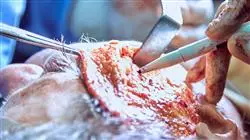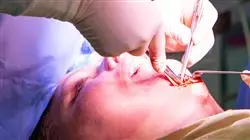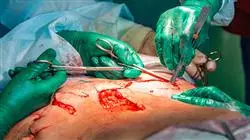University certificate
The world's largest faculty of medicine”
Description
The current importance of image and aesthetics makes this professional master’s degree an essential program for professionals in the sector, providing them with most in-depth knowledge of the main surgical techniques"

Aesthetic Plastic Surgery is one of the most booming sectors in recent years. The growing interest of citizens to improve their physical appearance, and the confidence offered by the advances in technology, have allowed these types of interventions to be performed with total safety, drastically minimizing the possible side effects. Although plastic surgery has historically focused on burn patients and reconstructive processes, it is increasingly acquiring a more generalized role, giving more space to patients who do not present a physical injury, but who demand surgical procedures to achieve an aesthetic or functional improvement.
This professional master’s degree in Aesthetic Plastic Surgery aims to broaden plastic surgeon’s knowledge and vision, providing a solid foundation to face the challenges posed by patients seeking aesthetic procedures and consolidate their previous training, while encouraging curiosity and interest in the most advanced techniques and the most consolidated knowledge of this fascinating discipline.
This program presents the most up-to-date knowledge in the management of cosmetic surgery patients. It was designed by a team of specialists who have developed an extensive catalog of multimedia material with illustrations, videos and case studies, supported by an extensive bibliography. The result is that all the knowledge is structured and explained in such a way that it allows a practical, systematic and simple application.
The most advanced surgical techniques, the indications for each patient according to their characteristics, the management of complications, or the use of current technologies for the optimization of results are explained step by step throughout each of the topics. The patient's protocols before surgery are also covered in the program, a key issue to avoid adverse events during the practice of Aesthetic Plastic Surgery. In addition, routine postoperative management is equally important, which consists of wound care and the application of therapies that help the patient progress until they can fully return to their daily activities.
This professional master’s degree offers you the most complete and up-to-date program, designed to learn about the technologies, materials, and treatments used in this discipline and to include a complete perspective of Aesthetic Plastic Surgery that will allow you to specialize in an ethical and responsible way. With this professional master’s degree, you will obtain a highly qualified education, which seeks to ensure excellence in medical practice. Furthermore, its 100% online format will allow you to continue your studies from the place of your choice, without having to commute or adhere to fixed schedules, and with a flexible methodology that will allow you to update your professional profile at your own pace.
An intense and thorough program, designed to provide in-depth knowledge of the most demanded technologies, materials and treatments"
This professional master’s degree in Aesthetic Plastic Surgery contains the most complete and up-to-date scientific program on the market. Its most notable features are:
- Practical cases presented by experts in Aesthetic Plastic Surgery
- The graphic, schematic, and practical contents with which they are created, provide scientific and practical information on the disciplines that are essential for professional development
- The latest information on Aesthetic Plastic Surgery
- Practical exercises where the self-assessment process can be carried out to improve learning
- Special emphasis on innovative methodologies in Aesthetic Plastic Surgery
- Theoretical lessons, questions to the expert, debate forums on controversial topics, and individual reflection work
- Content that is accessible from any , fixed or portable device , with an Internet connection
This professional master’s degree is the best investment you can make in the selection of a refresher program for two reasons: in addition to updating your knowledge in Aesthetic Plastic Surgery, you will obtain a degree from TECH Global University"
The teaching staff includes professionals from the field of Aesthetic Plastic Surgery, who bring their experience to this program, as well as renowned specialists from leading societies and prestigious universities.
The multimedia content, developed with the latest educational technology, will provide the professional with situated and contextual learning, i.e., a simulated environment that will provide immersive learning programmed to train in real situations.
This program is designed around Problem-Based Learning, whereby the professional must try to solve the different professional practice situations that arise throughout the program. For this, the Professional will have the help of an innovative interactive video system made by recognized experts in Aesthetic Plastic Surgery, who all have extensive experience.
Do not hesitate to study this program with us. You will find the best teaching material with virtual lessons"

This 100% online professional master’s degree will allow you to balance your studies with your professional work while increasing your knowledge in this field"
Objectives
The professional master’s degree in Aesthetic Plastic Surgery is aimed at facilitating the performance of the professional with the latest advances and newest treatments in the sector, enabling them to achieve superior training that allows them to act with total confidence in the cases that arise in their practice.

TECH offers you the most comprehensive education on the market in Aesthetic Plastic Surgery so that you can acquire a superior level of training that will elevate you to the professional elite’’
General objectives
- Present the anatomy of the breast region from a surgical perspective
- Define breast aesthetics and the current aesthetic ideal
- Describe the characteristics of the most frequently used breast implants
- Present the innovations in breast implants currently available to the plastic surgeon
- Establish the basis for mammoplasty surgery, augmentation, breast lift, or mastopexy and breast reduction surgery
- Describe the techniques for the treatment of tuberous breasts and the male breast region
- Know the anatomy of the topographic area to understand the process of appearance of the different imperfections of the area
- Examine the different basic techniques in ophthalmic plastic surgery
- Establish the surgical and anesthetic techniques of the area, as well as the perioperative management of the cosmetic surgery patient
- Analyze other alternative non-surgical techniques that provide Improvement of the imperfections of the area
- Generate specialized knowledge so that the surgeon can apply their knowledge in the different clinical cases presented to them
- Provide the necessary tools and key points in order to facilitate the performance of rhinoplasty
- Conceptualize the anatomy and aesthetics of the human body as a basis for body contouring lipoplasty
- Examine all important aspects related to the patient: patient choice, operating room safety, technologies to be used and anatomical areas to be treated
- Develop the most important practical concepts in fat transfer
- Determine the complications of procedures related to lipoplasty techniques
- Establish the most appropriate postoperative management and resources
- Conceptualize the anatomy of the abdominal wall and the aesthetics of the abdomen
- Determine the various surgical techniques that treat the abdominal wall
- Discuss the complications of procedures related to lipoplasty techniques
- Establish the management and resources used during the postoperative period
- Present the latest advances and best available surgical techniques that will provide the highest level of patient satisfaction in facial cosmetic surgery
- Examine the anatomy of the topographical area to understand the process of appearance of the different imperfections
- Establish the different basic techniques in facial surgery
- Identify other alternative non-surgical techniques that provide improvement of facial aging
- Present the anatomy and aesthetic analysis of the gluteal region
- Examine the different types of implants available for the treatment of this region
- Develop the different techniques in gluteoplasty with implants, the technique of autologous fat transfer to the buttocks and the gluteal augmentation technique combining implants and autologous fat
- Determine the complications of gluteal surgery according to each technique
- Examine the anatomy of the genital topographic area
- Analyze the process of genital transformation in the chronological evolution of the genus
- Determine the ethical considerations of cosmetic plastic surgery of the genitalia
- Develop the different basic techniques in genital surgery
- Address other alternative non-surgical techniques that provide genital enhancement
- Generate specialized knowledge regarding body aesthetics, upper extremities, lower extremities, hands, and feet
- Provide the necessary tools and relevant aspects for the management of the aesthetics of areas such as the ear, as well as the management of patients with special conditions
- Examine the latest procedures for beautification and rejuvenation of the lower limbs
- Assess the special conditions of patients who want to undergo plastic surgery procedures
- Examine the basics of the plastic surgery practice
- Determine preoperative prophylaxis protocols
- Establish the management of antibiotics and postoperative analgesics
- Detail the management of Postoperative garments and patient recovery
Specific objectives
Module 1. Aesthetic Breast Surgery
- Present all the anatomical elements of the breast region relevant to the surgical technique: those that make up the breast itself, the musculature used for pocket formation and the characteristics of the thorax, as well as irrigation, venous-lymphatic drainage and innervation
- Analyze the proportions of the breast and nipple-areola complex, to understand the diversity of aesthetics and existing preferences
- Determine the current characteristics of breast implants and the innovations available to the plastic surgeon and their indication in breast surgery
- Establish, in augmentation mammoplasty, patient selection, surgical approaches, the creation of each specific pocket and its indication, as well as the use of complementary techniques such as fat transfer for simple augmentation or combined with implants
- Examine, in mastopexy, the state of the breast to be operated on, the different scars used depending on the lift to be performed, as well as the techniques that use different pedicles and those that use implants
- Develop, in breast reduction surgery, the classification of hypertrophy, the different pedicles used, and the existing complications
- Describe the techniques of tuberous breast treatment with and without breast implants
- Present and describe the different techniques of breast symmetrization
- Establish the diagnosis and surgical treatment of the male breast region
Module 2. Periorbital and Upper Facial Surgery
- Define the anatomy of the orbital, periorbital, and upper face region
- Develop the aesthetic considerations of the periorbital region
- Examine the changes associated with aging
- Determine the different basic techniques in ophthalmic plastic surgery
- Analyze the steps of preoperative assessment
- Establish the specific surgical techniques
- Present the complementary procedures to palpebral surgery
Module 3. Aesthetic Nasal Surgery
- Reinforce the anatomical knowledge of the nasal region
- Enable the student to perform a complete analysis of the nose and to relate it according to the variation of the anatomical characteristics of each patient, without forgetting that the concept of beauty is different not only between men and women, but also according to the ethnic features of the subject to be treated
- Address significant knowledge of photography to carry out a correct documentation of the cases
- Generate specialized training in the surgical techniques used in rhinoplasty, from the simplest to the most complex, including the most innovative techniques
- Develop the main fundamentals for the plastic surgeon to be able to perform cartilage grafting, avoiding complications as much as possible
- Make the plastic surgeon aware that cosmetic rhinoplasty should not affect the functions of the nose
Module 4. Body Contouring Lipoplasty
- Develop the most relevant anatomical concepts for the surgeon in body contouring lipoplasty
- Present the aesthetics of the human body as a guide to obtain the results
- Determine the criteria for patient selection in body contouring lipoplasty
- Examine patient safety parameters
- Establish the tools and technologies commonly used for lipoplasties
- Address high-definition liposuction techniques in the various anatomical regions of interest for the technique
Module 5. Aesthetic Surgery of the Abdominal Wall
- Delve into the concepts of fat tissue transfer and its techniques
- Examine the techniques for aesthetic enhancement of the gluteal region with implants and the complications according to each procedure
- Present the postoperative management of the patient
- Develop the most relevant surgical-anatomical concepts for the development of the techniques
- Present the aesthetic units that make up the abdomen to restore them during surgery
- Determine the most frequently used abdominoplasty techniques based on the preoperative diagnosis of the abdomen
- Examine the most advanced techniques for the confection of the umbilicus in abdominoplasty
- Analyze the techniques for resection of large dermal fat flaps in patients with massive weight loss
- Establish the complications according to each procedure
- Address postoperative management of the patient
Module 6. Facial and Cervical Rejuvenation Surgery
- Examine the anatomy of the face and neck
- Determine the aesthetic considerations of the facial and neck region
- Analyze the changes associated with aging
- Develop the different surgical techniques used in the management of SMAS
- Analyze the steps of preoperative assessment
- Establish the possible operative complications that are attributed to each procedure
- Show the complementary procedures used for the management of cervical-facial aging
Module 7. Aesthetic Gluteal Surgery
- Analyze the topographic anatomy of the gluteal region detailing its musculature, vascularization, and innervation
- Determine the anatomical elements that integrate the aesthetic analysis of the gluteal region and present the aesthetic ideal of the gluteus
- Examine the diversity in gluteal implants, their characteristics and their indication in patients
- Approach the different surgical techniques used in gluteoplasty with implants
- Establish the surgical technique of autologous fat tissue transfer from its procurement, processing, and transfer, as well as to know the physiology of fat grafting
- Develop the surgical technique of autologous fat tissue transfer combined with gluteal implants
- Analyze the possible operative complications inherent to each procedure
Module 8. Intimate Surgery
- Examine the anatomy of the genitalia
- Establish the aesthetic considerations of ideal genitalia
- Analyze the different surgical techniques used in the management of genital pathologies
- Examine the possible operative complications associated with each procedure
- Show the complementary procedures used for the management of genital pathologies
Module 9. Other Surgical and Non-Surgical Aesthetic Procedures
- Conceptualize alopecia, causes, and treatment
- Develop specialized knowledge about congenital or acquired ear alterations, as well as the conduct to follow in the different cases
- Establish an action protocol for the definition of upper and lower extremities
- Analyze the different immunological pathologies, post-surgical conditions and/or physiological states that produce hormonal alterations in order to correctly approach the different surgical procedures
- Expand advanced knowledge regarding hand and foot aesthetics
- Provide the main fundamentals for the plastic surgeon to be able to differentiate the different non-surgical aesthetic processes, their basis and indications
Module 10. Protocols for the Aesthetic Surgery Patient
- Examine the characteristics of the aesthetic surgery patient from a psychological point of view, expectations, and reasons why they want to transform their appearance
- Provide the necessary tools for the assessment in consultation and management of social networks
- Determine the importance of medical photography as a tool for documentation of cases, and address the technical aspect of taking medical photographs
- Analyze the prophylaxis of cardiovascular events through the caprini scale
- Present anesthesia protocols, surgical risk and outpatient management through the ERAS protocol
- Determine the Postoperative management of the patient: antibiotic treatment, analgesia, Postoperative garments and recovery

Our goal is to achieve academic excellence and to help you achieve it"
Professional Master's Degree in Aesthetic Plastic Surgery
In the past, surgical procedures to modify the face or certain anatomical parts were solely for medical reasons, such as reconstructing skin burned during a war. Today, although such interventions continue to be fundamental to saving lives or restoring an individual's health, they have been given a new focus within an ever-growing market, the aesthetic one. As medical personnel must always be at the forefront of the new trends and needs of the sector, at TECH Global University we present the Professional Master's Degree in Aesthetic Plastic Surgery, a sophisticated program conceived from the versatility offered by online education to train the next body enhancement specialists. Through a rigorous but interactive and motivating syllabus, we will teach you all about the considerations and procedures to successfully perform the different types of surgeries and their variants: breast, nasal, lipoplasty, facial and cervical rejuvenation, etc. Do you want to learn the new digital technologies, the principles of medical photography and the legal implications of the treatments? Here at TECH you will find everything you need to become one of the most remarkable doctors in the field.
Dare to become the best plastic surgeon
There are not few cases where patients, encouraged by the desire to improve their aesthetic image, resort to alleged specialists who perform low-quality procedures, even compromising their health and/or generating complex legal investigations. In Colombia, during September 2021, a Puerto Rican woman died after undergoing liposuction. The subject is a thorny one and raises thick debates, however, one thing is certain, it requires total professionalism, aptitudinal confidence and integrity to perform an aesthetic procedure that satisfies the patient. Our program is designed precisely to equip you with the highest working skills so that you can perform safely in the operating room. You will witness why our Relearning methodology leads in the field of online teaching, in addition to being motivated by a teaching team with extensive experience in cosmetic surgery. In a world driven by digital globalization, where appearance prevails, we transform you to be that recognized name in the aesthetic clinic area.







